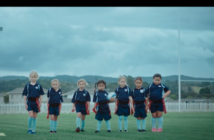During Chopper Appeal month, Westpac in partnership with with DDB, Facebook and Starcom released a series of four confronting videos that show the horror of a woman trapped in a car.
Shot by the Sweet Shop, the first three videos play out over the course of an evening, providing a glimpse at the claustrophobia and loneliness that typifies a car crash along one of the many remote roads in New Zealand.
Over the course of the campaign, the trio of clips have played on the timelines of regular Facebook users over the age of 18, building tension and encouraging them to visit chopperappeal.co.nz to see how the story ends.
“The use of video footage, created specifically for online, is an example of how content is evolving past passive viewing and into driving engagement,” says Westpac’s Westpac’s head of brand and marketing Oliver Lynch. “The partnering of emotive storytelling and a smart media strategy from Starcom ensures that the story is built over time to drive the point home that every second counts.”
Fortunately, in the final clip, the repetitive thud of helicopter blades is introduced, bringing an end to the trauma experienced by the protagonist.
And while the campaign is a tough watch and has been met with divisive responses on social media, Lynch says the aim was to deliver a message that would make viewers take notice.
““There’s a lot of demand for the charity dollar in New Zealand and we wanted to cut through the clutter and deliver a message about the chopper that would be hard to ignore – that when you’re waiting for help to arrive, every second counts.”
Every year, there are 5,900 rescues carried out by rescue helicopters across the country. But flying large metallic contraptions through the sky isn’t cheap, and this means that funds raised by the annual chopper appeal play a significant role in keeping the helicopters in the sky.
In 2014, the Westpac Chopper Appeal raised $1.38 million with all donations being distributed back to the 16 rescue chopper services across the country, and Westpac has set a target of $1 million for the latest edition.
“We hope that the campaign captures the imagination of New Zealanders,” says Lynch. “By showing the woman being rescued, it serves to highlight that every donation has a direct impact on helping to save lives.”
While the campaign appeals to our more empathetic side in that we do not want to see the woman suffering, it also reaches the more self-interested side of human nature on account of the fact that most viewers would want to be saved if they were in similar situation.
By forcing viewers to vicariously experience the horror of an ordinary Kiwi, the series of videos serve as a reminder that we are all just a simple accident away from being in a similar situation.
In a study published by Stanford University in 2014, researchers found that self-interest played a significant role in determining whether male donors, in particular, were likely to support a cause.
According to online publication The Chronicle of Philanthropy, participants in the study were offered four different pitches, each of which appealed to a different motivation:
“The efficacy pitch stated that “more than 98 percent of donations go on to directly to benefit the poor.” The conformity pitch suggested that many other donors were getting involved. The injustice appeal stated that people “born into poverty never had the opportunities that other Americans had.”
None of those approaches brought the male potential donors’ willingness to give or volunteer up to par with their female counterparts.
The fourth type of pitch, designed to trigger a sense of self-interest, included the statement, “Poverty weighs down our interconnected economy, exacerbating many social problems like crime.” It was the only type of appeal that raised men’s willingness to give money or volunteer at a rate comparable to that of women.”
So, by incorporating both an empathetic and self-interested angle, the Chopper Appeal could, at least in theory, reach a broader target audience, despite the divisiveness of the message. However, the effectiveness of the campaign will ultimately be measured by the number of coins collected.
Credits:
Client
Head of Brand & Marketing: Oliver Lynch
Brand Manager: Amber Willett
Agencies
Agency: DDB Group New Zealand
Chief Creative Officer: Damon Stapleton
Executive Creative Director: Shane Bradnick
Digital Creative Director: Haydn Kerr
Senior Copywriter: Ben Pegler
Art Director: Sarsha Drakeford
Copywriter: Geordie Wilson
Planning Director: Rupert Price
Managing Partner: Elizabeth Beatty
Account Director: Mark Wilson
Senior Account Manager: Deepika Goundar
Account Executive: Kate Coppersmith
Executive Producer: Judy Thompson
Agency TV Producer: Samantha Royal
Digital Designer: Dean Pomfrett
Senior Digital Producer: Johannes Gertz
Production Company: The Sweet Shop
Director: Sam Holst
Executive Producer: Fiona King
Producer: Anna Stuart
DOP: Ian McCarroll
Offline Editor: Michael Lonsdale
Sound Design: The Coopers
Starcom (Media)
Business Director: Paula Adams
Business Manager: John Farrell
Head of Digital: Nick Boulstridge
Digital Business Manager: Nathan Brown
Digital Manager: Max Havaux




